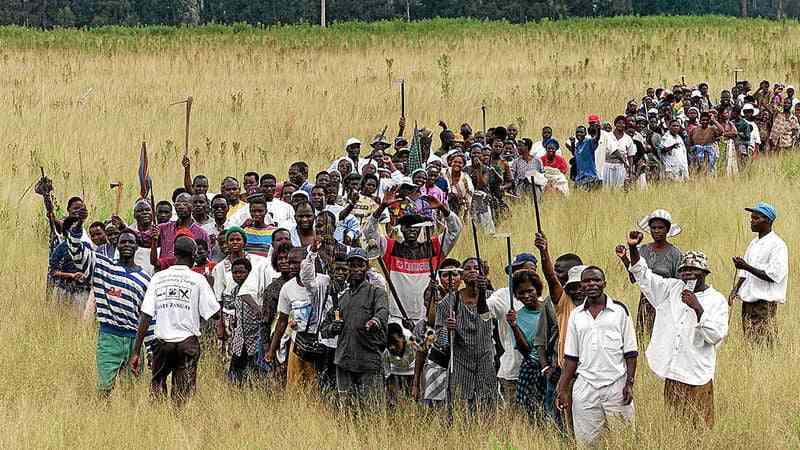
A CENTRAL question for our new research exploring changes in livelihoods 25 years after the land reform is what are the trajectories of accumulation — or, indeed, the opposite?
In other words, how well have those who got land following the land reform of 2000 fared?
The farmers occupying the small- and medium-scale farms (A1 and A2 respectively) from 2000 are not typical “subsistence peasants”, but are firmly linked into the wider capitalist market economy, accumulating and investing in their farms as well as off-farm businesses.
Many A1 farmers can be characterised as “petty commodity producers” where capital and family labour are combined in a small-scale enterprise.
Some larger A2 farmers are emerging as more typical capitalist farmers.
Most land reform beneficiaries combine off-farm work or rely on remittances or other endeavours and may be characterised as “worker-farmers” or “farmer-workers”.
Artisanal mining is an important livelihood in some of our sites, so combinations of mining and farming in livelihood portfolios are common.
There is no simple pattern and there have been diverse outcomes following land reform — some succeeding, some failing and many somewhere in between and varying over time.
- Minister bemoans shortage of schools
- BCC joins Green Cities initiative
- Drunkard kills church pastor
- Building solid markets for Zim artisanal miners
Keep Reading
It’s a complex story, but one we are beginning to unravel.
This article series of “accumulation dynamics” draws on around 100 household biographies collected across our sites in Mvurwi (a high potential agricultural area to the north of Harare dominated by tobacco production), Masvingo (including sites in both Masvingo and Gutu districts, a medium-potential area where maize and horticulture are central to livelihoods) and Matobo (a dry, low-potential livestock production area in Matabeleland South).
As subsequent articles in this series show, the type of production system and agroecology has a big influence on accumulation dynamics.
Tobacco is a highly labour- and capital-intensive crop, but with contracting support can generate significant revenue, allowing sustained accumulation for many in Mvurwi.
Maize, which is important in all sites, but perhaps especially in Masvingo, is largely rainfed and surplus production is dependent on a good season.
It is very much a boom-and-bust cycle, equilibrated by grain storage, but with pulses of investment over time.
Horticultural production is more stable as it is largely irrigated but is dependent on market demand and so incomes are volatile even if output is stable.
Livestock is important in all areas, but more as inputs to agriculture (manure and draft power) in Mvurwi and Masvingo, whereas in Matobo cattle are sold and are central to investment and accumulation.
Droughts and disease have major impacts on livestock populations in a “non-equilibrium” rangeland environment, so again investments are uneven over time, as livestock herds may increase slowly through births and die rapidly due to drought events, resulting in a stuttering pattern of accumulation.
The biographies have explored the story of different households across the 25-year period since the 2000 land reform, exploring the ups and downs experienced and their reasons.
We asked about both men and women as household heads, as well as young people — the children and younger relatives living in the land reform site home — as well as exploring the lives of workers, both those in the “compounds” in Mvurwi and others working for land reform farmers.
What is clear is that the land reform story is not a linear one nor one that can be described simply, but in advance of our major resurvey of around 2 000 households across these sites during this year, we are tentatively trying to tease out some of the key patterns.
Patterns of accumulation
What then are the main patterns of accumulation, what are the dynamics over time, what are the drivers and wider contexts for both success and failure?
In this series of four articles spaced over a fortnight each (as they are quite long), we will offer some preliminary reflections.
Four main patterns of accumulation are seen — from below, from above, from outside and decumulation or decline.
Accumulation from below is a classic dynamic that we have seen across our A1 sites in particular.
This involves the generation of farm-based surpluses and their sale, resulting in reinvestment on the farm.
Investments may be in farm inputs, equipment, irrigation, mechanisation, transport, housing or other aspects that improve the farm operations and the quality of life on the farm.
In our earlier studies we found between 40% and 60% of farmers producing more than a tonne of maize on average each year (some much more).
A tonne of maize is sufficient to feed a household, so anything more than this could be sold to generate income.
Many have diversified away from maize and so calculating surpluses is much more complex these days.
Although the patterns have changed, accumulation from below remains a central dynamic and we can expect a similar proportion to be accumulating in this way today; something we will be exploring in our new survey.
Accumulation from above represents a different route to investment, making use of patronage connections to acquire assets and inputs and so driving investment and accumulation on farm.
In the early years of land reform, we saw this operating particularly around the allocation of land in A2 farms, whereby those with political connections were able to acquire land and later gain access to resources through government schemes.
In our Mvurwi and Matobo sites, for example, those with “war veteran” status and those with direct connections to the ruling party were able to secure A2 farms.
This represented a quarter to half of A2 allocations in these sites, exceeding the 20% quota for war veterans in the official policy.
Far fewer got access to government schemes through patronage routes, whether the farm mechanisation scheme or later command agriculture, but these did provide routes to accumulate from above, allowing some to get going.
Many who benefited initially as war veterans, however, did not have the capital or business acumen to continue and ultimately failed.
So, despite the narrative that the land reform was dominated by party “cronies”, this has to be qualified, and accumulation from above has only been useful for a few and only in certain periods.
Accumulation from outside is a much more common strategy than patronage “from above” and takes many forms.
Most land reform households have connections outside the farm.
They may be sons and daughters working away, often in the diaspora, who provide remittances or may invest themselves in projects on the parents’ farm.
They may be to businesses run by the farm owner who links the farm to a wider portfolio of businesses.
Or they may be to mining, often resulting in sudden windfalls, that can be channelled to farm investments.
The farm-off-farm, rural-urban and Zimbabwe-diaspora linkages are key in understanding how accumulation dynamics play out and these relationships change over time, depending on household demographics and wider economic and political changes, locally or internationally.
Decumulation and decline represents the opposite of the above processes, when accumulation from below, above or outside fails due to poor harvests because of drought, loss of livestock due to disease or drought, loss of health and old age, failure of businesses, loss of jobs in towns or outside the country and so on.
Usually, it is a combination of shocks that results in a loss of assets and so income, with the result that accumulation is no longer possible and people’s fortunes decline.
Again, over time, things change — a period of accumulation can be followed by periods of loss, followed by recovery.
Over 25 years, a lot has happened.
Temporalities of accumulation
In our work, both through the household biographies and the repeat surveys, we are trying to track changes over time across 25 years.
These changes are far from linear and predictable, as our discussion of “transitions” emerging from comparing success ranks over time showed.
We again see a number of different patterns.
Many saw a slow start following the acquisition of land and then a patient, gradual improvement often from virtually nothing into a period of accumulation as surpluses were generated.
This is the classic pattern of “accumulation from below” and is widely seen across the A1 households, as well as some A2 farmers who have managed to finance their farms and some former farm workers, who are now more worker-farmers as they acquired small areas of land.
This remains the dominant pattern, but as the 25 years has unfolded this story of success has to be qualified, as the previous article highlighted.
For example, for some the upwards direction has slowed as droughts have struck cropping outputs and disease has decimated livestock (notably January disease in the past few years).
A focus on farm-based accumulation has changed as people diversify off-farm towards other investments.
People may be accumulating, but through town-based businesses, real estate rentals and so on.
And the trajectory of accumulation slows too as household heads become older, with less energy and sometimes constrained through ill-health and death of a household head (often the man).
Another pattern we see is when people arrived with assets — often A2 farmers who were able to invest in farms from the beginning — but then we see a steady decline, as they struggle with difficult economic conditions (even if the government of national unity (GNU) period from 2009-13 provided some respite), as well as the demographic impacts of becoming older, before sons or daughters could take over.
In another pattern, some started off poor and under-capitalised, but were able to invest through windfalls from outside — such as via mining — or above — through patronage links — but were again not able to sustain this and the farm business declined over time.
However, there were others who were able to make use of these external injections to establish, and then continued on a successful trajectory of improvement based on accumulation from below.
Different contingent and contextual factors influenced the outcomes, as we will see in the case studies in subsequent articles.
Patterns of decline — often from periods of success — are seen in a number of households, where old age, illness, death in the family or the collapse of an external business or loss of jobs intervened.
This accelerated during the COVID-19 pandemic as many returned from South Africa, for instance, or when remittances declined from Europe or North America.
Decline could be sudden or protracted and we are seeing this particularly around those who gained land 25 years ago in their prime, but are now in their 60s and 70s (or have died) and the succession to the next generation remains uncertain (see earlier article).
Contexts matter
Much depends on the wider context.
Over the last 25 years in Zimbabwe, there have been many changes in environmental, political and economic conditions that have had major impacts on accumulation patterns.
Good rainfall years may result in pulses of investment after a good harvest, but they may be followed by poor harvests due to drought.
Insulating against this through irrigation has been an important part of people’s investments over the past decade or more in particular, but agricultural production is still reliant on the weather and so climate change is unquestionably having an influence on accumulation dynamics.
Economic conditions in Zimbabwe have been a roller-coaster over this period, with multiple currencies, periods of hyperinflation and an investment climate severely affected by the wider political situation.
External support from donors has been restricted in the land reform areas through “sanctions”, while lack of finance for agriculture has been influenced by wider international relations.
Although Chinese investment has continued it has been narrowly focused, while Western finance has largely kept away from Zimbabwe given the risks.
The COVID-19 pandemic added another dimension, influencing job opportunities, remittance flows and so on.
Meanwhile, visa rules in Europe and North America and xenophobic discrimination and violence in South Africa has affected migration flows and so the ability to get jobs abroad.
The only period of relative stability was the GNU period when political and economic conditions improved and the possibilities of farm enterprises —especially in the A2 areas — could be realised temporarily and provided the foundation for an important period of investment on these farms.
Making sense of non-linear change
Linking these wider contextual factors to particular household trajectories of accumulation (or decline) helps to makes sense of changes.
External, wider factors inevitably with other local factors, such as demographic changes and contingencies such as ill-health, death and so on.
As the subsequent articles show, all combinations are possible, requiring a contextualised conjunctural analysis.
Patterns of accumulation and so investment and success are non-linear and hugely varied and can change rapidly over time.
This has huge implications for patterns of social differentiation within and across the land reform areas, and so patterns of class formation, wider political alliances and so on.
Understanding accumulation, therefore, has many ramifications, way beyond the particular material effects on people’s livelihood trajectories.
It’s certainly an extraordinarily complex story to unravel.
The next three articles (waiting a fortnight for each) will take each of our sites — Mvurwi, Gutu/Masvingo and Matobo — in turn and offer some case studies to highlight some of these patterns.










